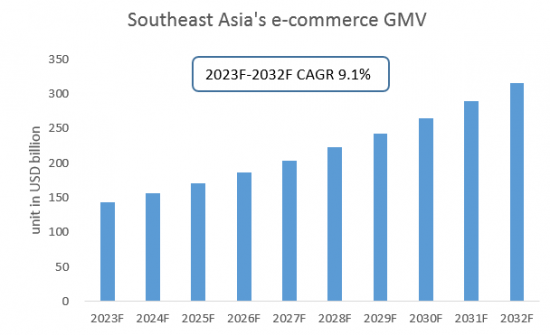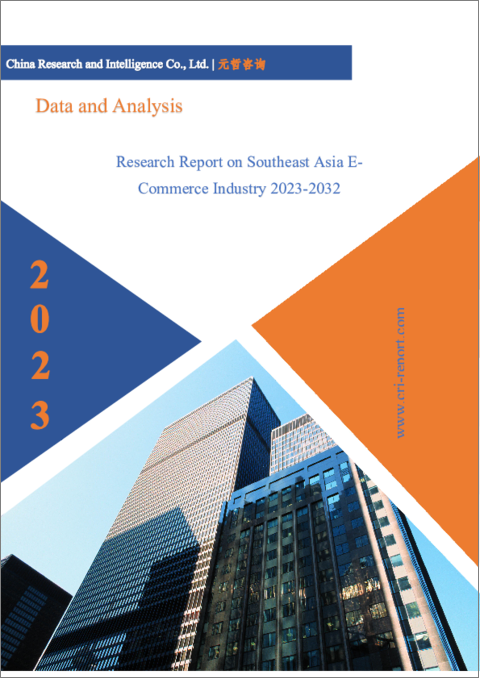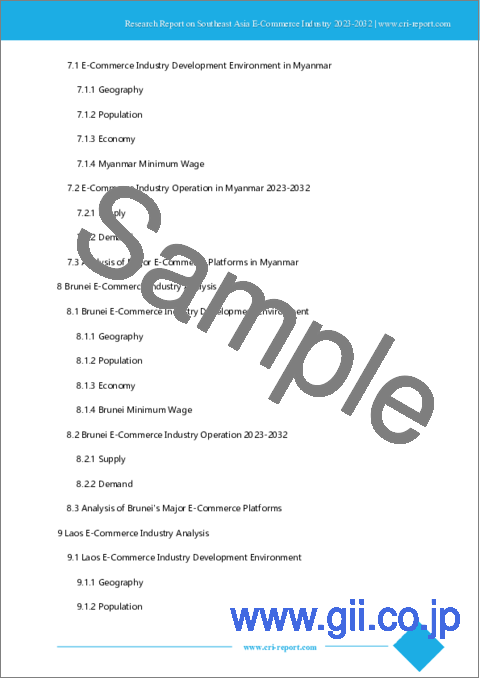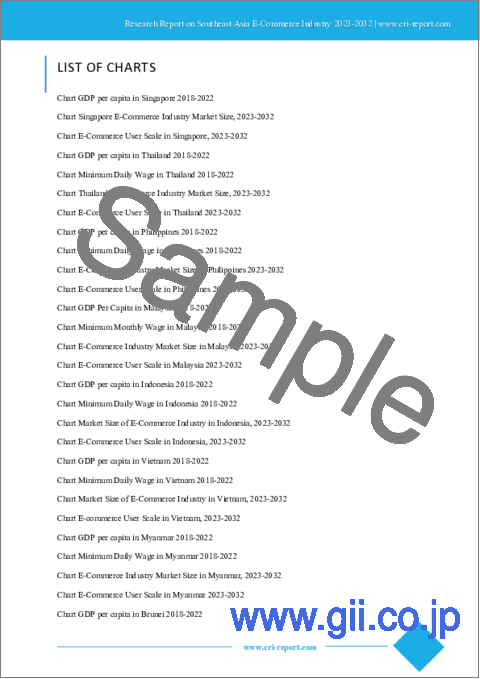|
|
市場調査レポート
商品コード
1231848
東南アジアのeコマース産業(2023年~2032年)Research Report on Southeast Asia E-Commerce Industry 2023-2032 |
||||||
| 東南アジアのeコマース産業(2023年~2032年) |
|
出版日: 2023年03月01日
発行: China Research and Intelligence
ページ情報: 英文 80 Pages
納期: 即日から翌営業日
|
- 全表示
- 概要
- 目次
東南アジアのeコマースの市場規模は、2017年~2022年にGMVで109億米ドルから1,310億米ドルに急増し、CAGRで64%の成長が予測されています。住民の1人あたりの可処分所得の増加、モバイルインターネットの普及、消費習慣の緩やかな変化に伴い、東南アジアのeコマース産業が徐々に発展しています。
当レポートでは、東南アジアのeコマース産業について調査分析し、主な促進要因、課題と機会、COVID-19の影響などの情報を提供しています。
目次
第1章 シンガポールのeコマース産業の分析
- シンガポールのeコマース産業の開発環境
- 地域
- 人口
- 経済
- シンガポールの最低賃金
- シンガポールのeコマース産業の経営(2023年~2032年)
- 供給
- 需要
- シンガポールの主なeコマースプラットフォームの分析
第2章 タイのeコマース産業の分析
- タイのeコマース産業の開発環境
- 地域
- 人口
- 経済
- タイの最低賃金
- タイのeコマース産業の経営(2023年~2032年)
- 供給
- 需要
- タイの主なeコマースプラットフォームの分析
第3章 フィリピンのeコマース産業の分析
- フィリピンのeコマース産業の開発環境
- 地域
- 人口
- 経済
- フィリピンの最低賃金
- フィリピンのeコマース産業の経営(2023年~2032年)
- 供給
- 需要
- フィリピンの主なeコマースプラットフォームの分析
第4章 マレーシアのeコマース産業の分析
- マレーシアのeコマース産業の開発環境
- 地域
- 人口
- 経済
- マレーシアの最低賃金
- マレーシアのeコマース産業の経営(2023年~2032年)
- 供給
- 需要
- マレーシアの主なeコマースプラットフォームの分析
第5章 インドネシアのeコマース産業の分析
- インドネシアのeコマース産業の開発環境
- 地域
- 人口
- 経済
- インドネシアの最低賃金
- インドネシアのeコマース産業の経営(2023年~2032年)
- 供給
- 需要
- インドネシアの主なeコマースプラットフォームの分析
第6章 ベトナムのeコマース産業の分析
- ベトナムのeコマース産業の開発環境
- 地域
- 人口
- 経済
- ベトナムの最低賃金
- ベトナムのeコマース産業の経営(2023年~2032年)
- 供給
- 需要
- ベトナムの主なeコマースプラットフォームの分析
第7章 ミャンマーのeコマース産業の分析
- ミャンマーのeコマース産業の開発環境
- 地域
- 人口
- 経済
- ミャンマーの最低賃金
- ミャンマーのeコマース産業の経営(2023年~2032年)
- 供給
- 需要
- ミャンマーの主なeコマースプラットフォームの分析
第8章 ブルネイのeコマース産業の分析
- ブルネイのeコマース産業の開発環境
- 地域
- 人口
- 経済
- ブルネイの最低賃金
- ブルネイのeコマース産業の経営(2023年~2032年)
- 供給
- 需要
- ブルネイの主なeコマースプラットフォームの分析
第9章 ラオスのeコマース産業の分析
- ラオスのeコマース産業の開発環境
- 地域
- 人口
- 経済
- ラオスの最低賃金
- ラオスのeコマース産業の経営(2023年~2032年)
- 供給
- 需要
- ラオスの主なeコマースプラットフォームの分析
第10章 カンボジアのeコマース産業の分析
- カンボジアのeコマース産業の開発環境
- 地域
- 人口
- 経済
- カンボジアの最低賃金
- カンボジアのeコマース産業の経営(2023年~2032年)
- 供給
- 需要
- カンボジアの主なeコマースプラットフォームの分析
第11章 東南アジアのeコマース産業の見通し(2023年~2032年)
- 東南アジアのeコマース産業の発展に影響を与える要因の分析
- 有利な要因
- 不利な要因
- 東南アジアのeコマース産業の供給の分析(2023年~2032年)
- 東南アジアのeコマース産業の需要の分析(2023年~2032年)
- eコマース産業に対するCOVID-19の流行の影響
Southeast Asia is the emerging market with the fastest economic growth and greatest development potential in the world. With the increase in per capita disposable income of Southeast Asian residents, the increase in mobile Internet penetration and the gradual shift in consumption habits, the e-commerce industry in Southeast Asia has gradually developed. According to a third-party study, the GMV of e-commerce will jump from US$10.9 billion to US$131 billion from 2017-2022, with a compound annual growth rate of 64%.
SAMPLE VIEW

There are differences in the development of e-commerce industry among Southeast Asian countries. According to CRI's analysis, Singapore has a well-developed e-commerce industry, and the largest online e-commerce platforms in Southeast Asia, Shopee and Lazada, are both headquartered in Singapore; Malaysia has a high Internet penetration rate and a mature e-commerce market; Indonesia has a population of more than 274 million, and its huge population makes Indonesia have the largest e-commerce market in Southeast Asia. The e-commerce industry in the Philippines, Vietnam and Thailand are in the growth explosion period, developing rapidly and with great potential.
Southeast Asia in this report includes 10 countries: Singapore, Thailand, Philippines, Malaysia, Indonesia, Vietnam, Myanmar, Brunei, Laos and Cambodia. With a total population of over 600 million by the end of 2021, Southeast Asia has an overall economic growth rate higher than the global average and is one of the key drivers of future global economic growth.
According to CRI's analysis, the economic levels of the 10 Southeast Asian countries vary greatly, with Singapore being the only developed country with a per capita GDP of about US$73,000 in 2021. While Myanmar and Cambodia will have a GDP per capita of less than US$2,000 in 2021. The population and minimum wage levels of each country also vary greatly. Brunei, which has the smallest population, will have a total population of less than 500,000 people in 2021, while Indonesia, which has the largest population, will have a population of about 275 million people in 2021.
CRI expects the Southeast Asian e-commerce industry to maintain growth from 2023-2032. On the one hand, the number of online shopping users in Southeast Asia has been increasing year after year, showing a trend of rejuvenation and huge potential for consumption growth. On the other hand, Southeast Asia's digital financial services, such as online payment and microfinance, continue to develop, driving the scale of Southeast Asia's e-commerce industry to continue to expand.
Topics covered:
- Southeast Asia E-Commerce Industry Status and Major Sources in 2018-2022
- What is the Impact of COVID-19 on Southeast Asia E-Commerce Industry?
- Which Companies are the Major Players in Southeast Asia E-Commerce Industry Market and What are their Competitive Benchmarks?
- Key Drivers and Market Opportunities in Southeast Asia E-Commerce Industry
- What are the Key Drivers, Challenges, and Opportunities for Southeast Asia E-Commerce Industry during 2023-2032?
- What is the Expected Revenue of Southeast Asia E-Commerce Industry during 2023-2032?
- What are the Strategies Adopted by the Key Players in the Market to Increase Their Market Share in the Industry?
- What are the Competitive Advantages of the Major Players in Southeast Asia E-Commerce Industry Market?
- Which Segment of Southeast Asia E-Commerce Industry is Expected to Dominate the Market in 2032?
- What are the Major Adverse Factors Facing Southeast Asia E-Commerce Industry?
Table of Contents
1 Singapore E-Commerce Industry Analysis
- 1.1 Singapore E-Commerce Industry Development Environment
- 1.1.1 Geography
- 1.1.2 Population
- 1.1.3 Economy
- 1.1.4 Minimum Wage in Singapore
- 1.2 Singapore E-Commerce Industry Operation 2023-2032
- 1.2.1 Supply
- 1.2.2 Demand
- 1.3 Analysis of Major E-Commerce Platforms in Singapore
2 Thailand E-Commerce Industry Analysis
- 2.1 Thailand E-Commerce Industry Development Environment
- 2.1.1 Geography
- 2.1.2 Population
- 2.1.3 Economy
- 2.1.4 Thailand Minimum Wage
- 2.2 Thailand E-Commerce Industry Operation 2023-2032
- 2.2.1 Supply
- 2.2.2 Demand
- 2.3 Analysis of Major E-Commerce Platforms in Thailand
3 Analysis of E-Commerce Industry in the Philippines
- 3.1 E-commerce Industry Development Environment in the Philippines
- 3.1.1 Geography
- 3.1.2 Population
- 3.1.3 Economy
- 3.1.4 Minimum Wage in the Philippines
- 3.2 Philippine E-Commerce Industry Operation 2023-2032
- 3.2.1 Supply
- 3.2.2 Demand
- 3.3 Analysis of Major E-Commerce Platforms in the Philippines
4 Malaysia E-Commerce Industry Analysis
- 4.1 Malaysia E-Commerce Industry Development Environment
- 4.1.1 Geography
- 4.1.2 Population
- 4.1.3 Economy
- 4.1.4 Minimum Wage in Malaysia
- 4.2 E-Commerce Industry Operation in Malaysia 2023-2032
- 4.2.1 Supply
- 4.2.2 Demand
- 4.3 Analysis of Major E-Commerce Platforms in Malaysia
5 Indonesia E-Commerce Industry Analysis
- 5.1 Indonesia E-Commerce Industry Development Environment
- 5.1.1 Geography
- 5.1.2 Population
- 5.1.3 Economy
- 5.1.4 Minimum Wage in Indonesia
- 5.2 Indonesia E-Commerce Industry Operation 2023-2032
- 5.2.1 Supply
- 5.2.2 Demand
- 5.3 Analysis of Major E-Commerce Platforms in Indonesia
6 Vietnam E-Commerce Industry Analysis
- 6.1 Development Environment of E-Commerce Industry in Vietnam
- 6.1.1 Geography
- 6.1.2 Population
- 6.1.3 Economy
- 6.1.4 Minimum Wage in Vietnam
- 6.2 Vietnam E-Commerce Industry Operation 2023-2032
- 6.2.1 Supply
- 6.2.2 Demand
- 6.3 Analysis of Major E-Commerce Platforms in Vietnam
7 Analysis of E-Commerce Industry in Myanmar
- 7.1 E-Commerce Industry Development Environment in Myanmar
- 7.1.1 Geography
- 7.1.2 Population
- 7.1.3 Economy
- 7.1.4 Myanmar Minimum Wage
- 7.2 E-Commerce Industry Operation in Myanmar 2023-2032
- 7.2.1 Supply
- 7.2.2 Demand
- 7.3 Analysis of Major E-Commerce Platforms in Myanmar
8 Brunei E-Commerce Industry Analysis
- 8.1 Brunei E-Commerce Industry Development Environment
- 8.1.1 Geography
- 8.1.2 Population
- 8.1.3 Economy
- 8.1.4 Brunei Minimum Wage
- 8.2 Brunei E-Commerce Industry Operation 2023-2032
- 8.2.1 Supply
- 8.2.2 Demand
- 8.3 Analysis of Brunei's Major E-Commerce Platforms
9 Laos E-Commerce Industry Analysis
- 9.1 Laos E-Commerce Industry Development Environment
- 9.1.1 Geography
- 9.1.2 Population
- 9.1.3 Economy
- 9.1.4 Minimum Wage in Laos
- 9.2 Laos E-Commerce Industry Operation 2023-2032
- 9.2.1 Supply
- 9.2.2 Demand
- 9.3 Analysis of Major E-Commerce Platforms in Laos
10 Cambodia E-Commerce Industry Analysis
- 10.1 Cambodia E-Commerce Industry Development Environment
- 10.1.1 Geography
- 10.1.2 Population
- 10.1.3 Economy
- 10.1.4 Minimum Wage in Cambodia
- 10.2 Cambodia E-Commerce Industry Operation in 2023-2032
- 10.2.1 Supply
- 10.2.2 Demand
- 10.3 Analysis of Major E-Commerce Platforms in Cambodia
11 Southeast Asia E-Commerce Industry Outlook 2023-2032
- 11.1 Analysis of Factors Affecting the Development of E-Commerce Industry in Southeast Asia
- 11.1.1 Favorable Factors
- 11.1.2 Unfavorable Factors
- 11.2 Supply Analysis of Southeast Asia E-Commerce Industry 2023-2032
- 11.3 Southeast Asia E-Commerce Industry Demand Analysis 2023-2032
- 11.4 Impact of COVID -19 Epidemic on E-Commerce Industry




